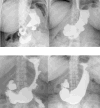Endoscopic sutured gastroplasty: procedure evolution from first-in-man cases through current technique
- PMID: 29075966
- PMCID: PMC5845469
- DOI: 10.1007/s00464-017-5869-2
Endoscopic sutured gastroplasty: procedure evolution from first-in-man cases through current technique
Abstract
Background: Endoscopic sutured gastroplasty (ESG) has evolved over time. With the advent of full-thickness endoscopic suturing, an efficient technique for ESG was developed and refined.
Methods: This prospective first-in-man trial started in April 2012 and represents the first use of full-thickness endoscopic suturing for primary obesity therapy. The trial focused on procedure development, reproducibility, safety, and short-term efficacy. The trial was performed at centers in five countries, in three phases. Phase I was evaluation of safety and technical feasibility of various procedure techniques; stitch patterns and sequences were assessed for efficiency, safety, and feasibility. Phase II entailed continued procedure refinement to establish a standardized technique. Phase III entailed evaluation of technical feasibility and weight loss outcomes in 77 patients; the procedure was performed using the standardized technique, and there was no procedure development. Data were prospectively collected into a registry.
Results: In Phase I, the procedure was created and modified to improve time efficiency. Safety and technical feasibility were established, and short-term weight loss was demonstrated. In Phase II, a number of stitch patterns were attempted, and the stitch pattern was modified and finalized. 22 patients were included, and 1-year total weight loss was 17.3 ± 2.6%. In Phase III, conformity with the final technique was high. 77 patients were included, with a mean BMI of 36.1 ± 0.6 kg/m2. Mean weight loss was 16.0 ± 0.8% at 6 months and 17.4 ± 1.2% at 12 months (n = 44). Postprocedural nausea, vomiting, and epigastric pain were frequently reported; there were no reported significant adverse events post-procedure or during the follow-up period.
Conclusions: Following a methodical procedure development phase, ESG demonstrated safety and short-term efficacy in this trial. The procedure also achieved meaningful weight loss during the follow-up period.
Keywords: Bariatric endoscopy; Bariatric surgery; Endoscopic bariatric; Endoscopic sleeve gastroplasty; Endoscopic sutured gastroplasty; Obesity; Weight loss surgery.
Conflict of interest statement
Drs. Kumar, Sahdala, and Jirapinyo have no conflicts of interest to disclose.
Figures




References
-
- Johnson EE, Simpson AN, Harvey JB, Lockett MA, Byrne KT, Simpson KN. Trends in bariatric surgery, 2002–2012: do changes parallel the obesity trend? Surg Obes Relat Dis. 2016 Feb;12(2):398–404. - PubMed
-
- Thompson CC, Carr-Locke DL, Saltzman J. Peroral endoscopic repair of staple-line dehiscence in Roux-en-Y gastric bypass: a less invasive approach [abstract] Gastroenterology. 2004;126(Suppl 2)
-
- Brethauer SA, Chand B, Schauer PR, Thompson CC. Transoral gastric volume reduction as intervention for weight management: 12-month follow-up of TRIM trial. Surg Obes Relat Dis. 2012 May-Jun;8(3):296–303. - PubMed
-
- Fogel R, De Fogel J, Bonilla Y, De La Fuente R. Clinical experience of transoral suturing for an endoluminal vertical gastroplasty: 1-year follow-up in 64 patients. Gastrointest Endosc. 2008 Jul;68(1):51–8. - PubMed
Publication types
MeSH terms
Grants and funding
LinkOut - more resources
Full Text Sources
Other Literature Sources
Medical
Miscellaneous

